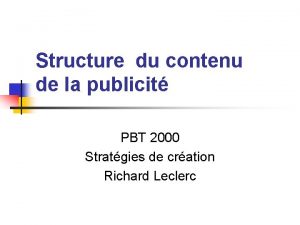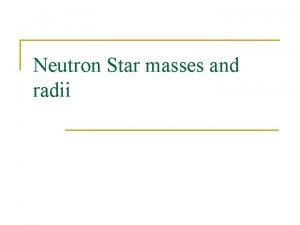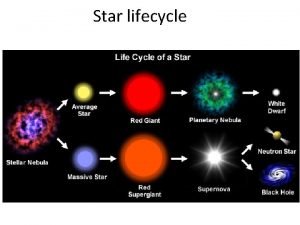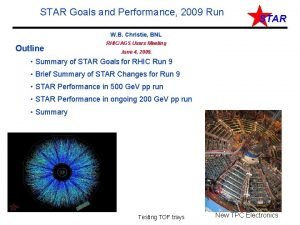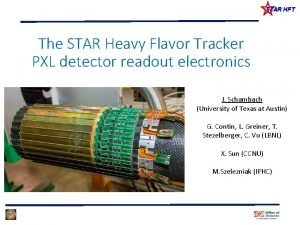STAR WHAT IS A STAR HOW IS A












- Slides: 12

STAR Ø Ø WHAT IS A STAR HOW IS A STAR BORN THE LIFE OF A STAR THE END OF A STAR

WHAT DO WE CALL A STAR To the astrophysicist, star is called every celestial object that can produce energy from nuclear reactions that take place in its core. Basically a star is any celestial object that can light itself up by burning its own fuel. This happens when temperature and pressure inside that object exceed a specific limit and also when the object has a certain mass.

Most stars are between 1 b and 10 b years old but some of them are almost as old as our universe. The oldest star that has been found is 13. 200. 000 years old. The smaller the star the longer it lives.

THE BIRTH A star is born when atoms of light elements (usually gases) are squeezed under enough pressure for their nuclei to undergo fusion. All stars are the result of a balance of forces: the force of gravity compresses atoms in interstellar gas until the fusion reactions begin. And once the fusion reactions begin, they exert an outward pressure. As long as the inward force of gravity and the outward force generated by the fusion reactions are equal, the star remains stable.

Clouds of gas are common in our galaxy and in other galaxies like ours. These clouds are called nebulae. A typical nebula is many light-years across and contains enough mass to make several thousand stars the size of our sun. The majority of the gas in nebulae consists of molecules of hydrogen and helium--but most nebulae also contain atoms of other elements, as well as some surprisingly complex organic molecules. These heavier atoms are remnants of older stars, which have exploded in an event we call a supernova.

THE MAIN SEQUENCE The main sequence is the puberty and the adulthood of a star. Stars spend the 90% of their lives fusing hydrogen near their core thanks to the high temperature and pressure that exist there. In the beginning of the main sequence we call these stars dwarf stars. These stars keep fusing hydrogen and producing helium and simultaneously they become hotter and brighter and bigger.

The time that each star spends in the main sequence depends on the quantity of fuel that it can fuse and from the initial brightness and mass of the star. The bigger stars consume their fuels much faster than the smaller stars and thus they live shorter.

As stars are running low of hydrogen, their outer layers expand become cooler and that’s what we call a Red Giant. In heavy enough Red Giants the core squeezes itself so much that the star can now begin to fuse helium. During this process the star becomes smaller and the temperature on its surface rises. The stars that exceed a mass limit will expand turn into Red Supergiants. When the star has fused all its helium the fusion process continues inside a shell of carbon and oxygen.

The core shrinks until the pressure is high enough to fuse carbon. If the star is old enough different shells are created and in the outer shell lighter atoms are fused while in the inner shells where the pressure and temperature are extremely high, heavier atoms become fused. The last stage of the main sequence is when the star has nothing else to make but ferum aka iron which is a very dense metal. After that it can’t fuse anything and that signals the end of the star.

THE END OF A STAR An average star will dispense its outer layers creating some sort of nebula. If the remains don’t have a certain mass then the star shrinks and creates a white dwarf which will later turn into a brown dwarf. If they do then the iron core wont be able to support such a dense object. Its protons will collide with its electrons and neutrinos will be created causing a disastrous explosion a supernova from which heavier atoms than ferum can be created.

This kind of explosion is able of illuminating the whole galaxy for a very short period of time exceeding the brightness of its on galaxy. The matter of the ex star then scatters and creates nebulae leaving only a pulsar aka neutron star or if the star was large enough, a black hole.

THE END OF A WONDERFUL PRESENTATION Clap!
 Star of wonder star of night star of royal beauty bright
Star of wonder star of night star of royal beauty bright Compare a* and ao* algorithm
Compare a* and ao* algorithm What does star (for star events) stand for?
What does star (for star events) stand for? La star stratégie
La star stratégie Star wars fat slug
Star wars fat slug Ttrock
Ttrock Strtoupper star wars
Strtoupper star wars How are barnard's star and antares alike
How are barnard's star and antares alike Simple present tense of light
Simple present tense of light Small basic turtle star code
Small basic turtle star code Neutron star
Neutron star Star lifecycle model
Star lifecycle model Who was leader before redstar
Who was leader before redstar



